Change. It can be scary and unknown and invites anxiety and stress. We’ve all heard that nobody likes change. But change is good, and it’s healthy and inevitable.
Gestión del cambio organizativo
Changes happen all the time. Some are successful, but many are not. Unsuccessful changes are likely due to very little preparation for that change.
Organizations don’t change; people do. Organizations set the strategy and objectives, but the people in the organization decide to get on board and support and affect that change.
And this is where Organizational Change Management (OCM) comes in. OCM is a process of managing the people side of change in an organization. It involves assessing the impact of change on employees, developing strategies to communicate and engage them, and supporting them through the transition process to engage, learn, adapt, and use a change in their daily work.
People don’t like to BE changed, but if they are part of the change, they BECOME the change.
Jack Welch, the successful one-time Chairman and CEO of GE, once said, ‘Don’t manage – lead change before you have to.’ Businesses that plan for and drive continuous change are more successful than those that change because they are forced to. Business needs will change over time, and change management should be a part of any business practice.
Getting started
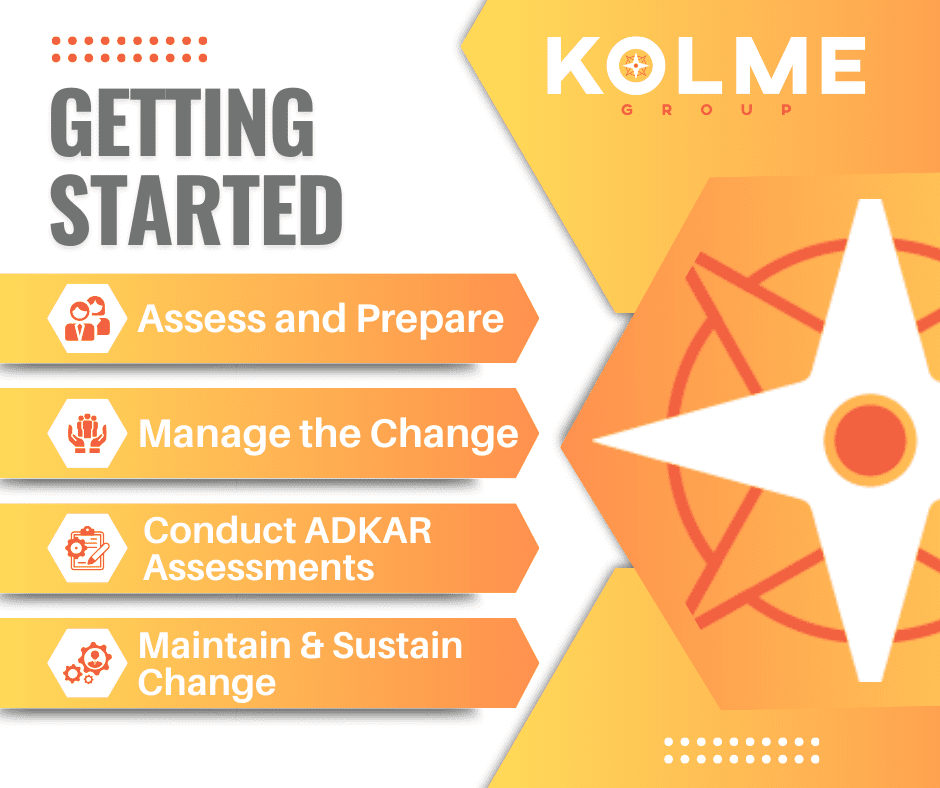
How to Get Started with OCM
Change Management can be daunting for those unfamiliar with it. With the right approach, you can ensure that your organization is prepared for any changes that might come its way.
Prosci is one Change Management methodology that can be used – there are many – these 3 phases of the Prosci approach are:
Assess and Prepare – the purpose of this first phase is:
- Establish sponsors and confirm their commitment to change.
- Define and capture the 4 P’s – what is the Project, the Purpose, the Particulars, and who are the People impacted?
- Define what success looks like.
- Assess the organization across four pillars: Project Management, Change Management, Leadership/sponsorship, and success.
- Assess the organization’s attributes and change characteristics to define the risk level of the change. This will inform the level of plans to be created and implemented to support the change.
From the people aspect, additional consideration will be required:
- Define the groups of impacted people. These cohorts will be the focus of the planning and will be tracked throughout the project.
- For each group, assess how the change will impact them and the degree of impact. Group impact could be vastly different by the same type of change, so ensure this is being measured.
- Proactively consider any resistance or challenges for each group to include in the strategy and plans. What will they have the most trouble with, and how can we ensure those items are addressed upfront?
- Identify resources and support structures for the change (sponsors, SMEs, etc.)
- Align the change timeline to the project schedule.
Define the Change Management strategy and review it with sponsors for alignment and sign-off.
Manage the Change – This phase involves creating, implementing, and adapting the Change plans.
- Using the information collected, create the Master Change Management Plan – which consists of 5 plans (Communications Plan, Sponsor Plan, Coaching Plan, Training Plan, Resistance Management Plan)
- Activate the Plans starting with Communication, Sponsor, Coaching, and Resistance Management.
Conduct ADKAR assessments.
This model consists of a 5-question survey delivered at different times of the project (usually 3-5 times). It is used to assess impacted individuals and their journey through change. It helps to identify barriers and gaps so that we can support them in adopting the change. Trends can be seen in how groups and individuals progress through the change journey.
Adapt planned actions based on feedback and ADKAR responses.
Maintain and Sustain the change – impacted individuals have been informed, included, assessed, trained, and supported. That’s not the end. The change needs to be sustained to be successful.
- Review and audit performance to ensure that individuals stick with the change.
- Identify gaps or enhancements and goals and prioritize them for implementation.
- Celebrate success!
Who leads all this?
Depending on several factors (organization size, change size and impact, etc.), a Change Manager may be identified to lead these activities. Sometimes, a Project Manager may play a hybrid role to carry out these tasks and project management-related activities.
Remember, change management’s focus is on the people that are affected by the change. Therefore, a separate Change Manager and Project Manager are recommended to ensure that the technical and people sides of the project are given the right amount of focus they need without sacrificing either.
Important roles
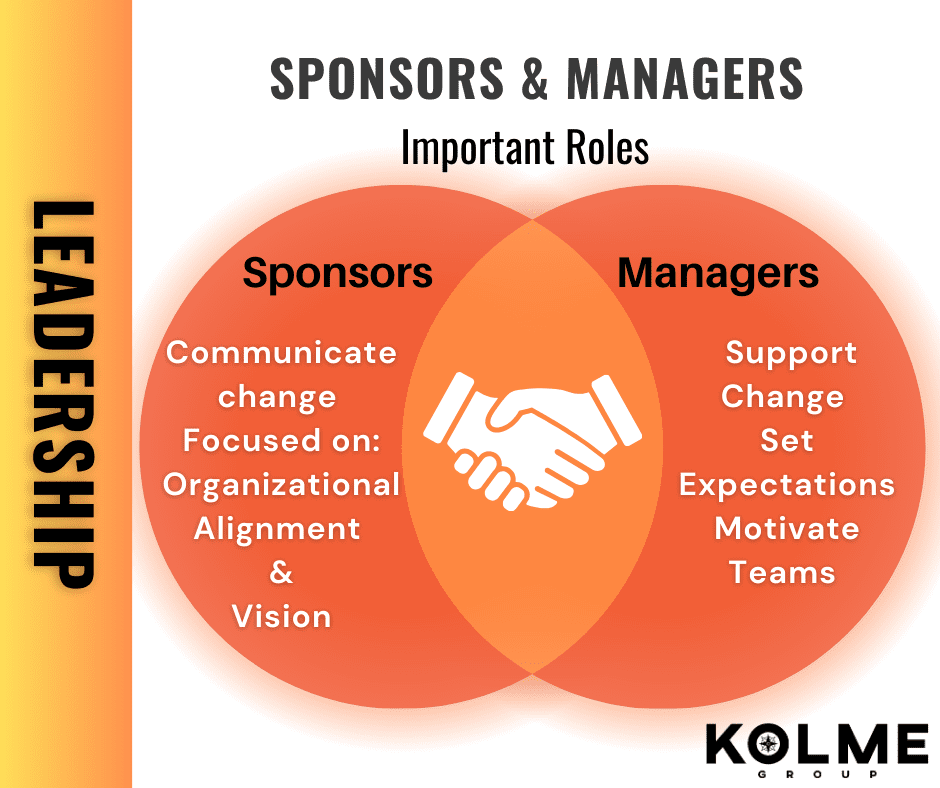
How Leadership Can Support OCM
Sponsors
A sponsor is someone who authorizes the change, is supportive of it, and promotes the change with their actions, behaviors, and conversations. This means they aren’t just signing a charter and are done with it. They must remain active and visibly participate throughout the project.
Sponsors should be involved in communicating the change to the employees. They can speak to how the change aligns with the organization’s vision, why it is needed, and the risks of not changing.
The Change Manager will coordinate efforts with the sponsor(s) to ensure the right level of involvement is planned through activities and communications.
To help support the change, Sponsors should take the lead in building and maintaining a sponsor coalition – a group of other key business leaders and stakeholders – to help support the change being implemented.
Managers
Successful change is driven and supported by the role of managers.
Managers support the change process, set expectations, and motivate their teams to embrace the changes.
As such, they must understand the change process and be able to identify potential risks and challenges for their groups to support the process and, ultimately, their direct reports. This is why managers are the first to embark on the journey of change.
It’s the same as the analogy of putting on your own oxygen mask first before you can help others. They must be aware and have embraced the change themselves before they can support their employees through it.
In addition to Sponsor communications, Managers must also be able to communicate effectively with their teams about the changes. The coaching plan will help managers understand why they are necessary for the success of the change.
Managers are the closest and likely most trusted by their direct reports. Therefore, they are in the best position to deliver essential messages about change and to be available to listen and respond to questions from their employees.
Managers will play multiple roles for their team.
- As a Communicator, they will ensure that their team members are aware of the changes coming and that the messages are clear and consistent.
- As a Liaison, they will share information such as progress, usability results, and feedback with the project team.
- As an Advocate of the change, the Manager will show support through their words and actions in active and observable ways.
- Finally, Managers will play the roles of Resistance Manager when pushback occurs and Coach to support their teams as they progress through the change.
Communicating About Change
Communicating information about the change is essential to building awareness and support for the change. These communications will be planned at different project stages, in various forms (multi-media), and originate from other people and sources. No matter the sender or timing, communication about the project must ensure consistent and clear messages are transmitted.
The Change Manager will work with the sponsor and project members to craft key messages and communications for the project, focusing on a few themes such as the business landscape today, messages about the change, how the change will impact employees, and the schedule of the change project.
The Communications Plan will detail each message’s content, timing, method, and preferred sender. These communications will be set for specific times: initiation of the project, during the design of the project, before implementation, during implementation, and post-implementation.
Using this strategy, messages can be crafted to logically provide information about the change, gradually providing more detail with each new communication.
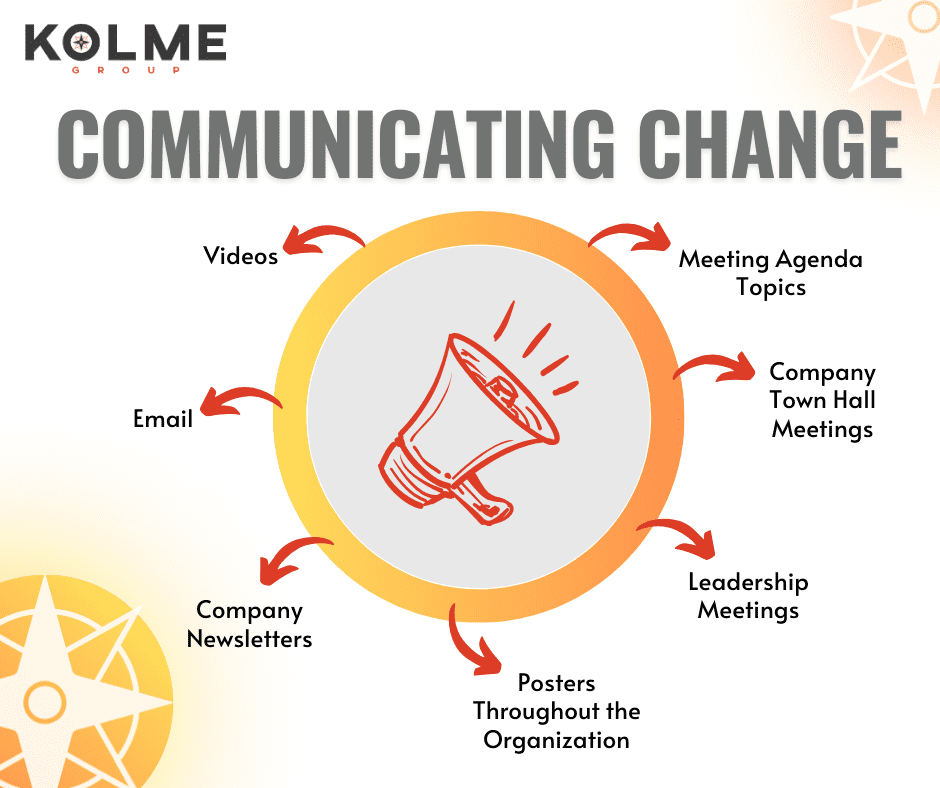
Communication is Key to Organizational Change Management
The delivery mechanism should also be varied.
Communication about the change could come in a variety of ways:
- Company newsletters
- Company town hall meetings
- Leadership meetings
- Meeting agenda topics
- Posters throughout the organization
- Videos
Because different people process information in different ways, varying the delivery mechanism of the messages will help ensure that more people can receive and process the message and ultimately raise their awareness of the change.
Preferred Sender
Research shows that employees prefer to hear messages from two organizational roles.
- Organizational messages address the organization’s perspective and the business reasons for change. These messages should come from executives and senior leaders.
- Immediate supervisors should be the sender of messages about the personal impacts that the change will have on employees. This is because they are the closest to the employees and are trusted; therefore, immediate supervisors will better deliver these messages.
Following this, the preferred sender will be considered and worked into the communication plan to ensure that the correct source delivers the messages to those impacted by the change.
Training Approaches and Best Practices
Depending on the change to be implemented, some or all of these should be considered. People learn in different ways and at different paces. Some best practices for training are as follows:
- Set expectations. Tell attendees what will be covered, the session’s objective, and the session’s length. Also, if specific materials, information, or access permission is required, detail that too so people are prepared.
In-person, face-to-face, or virtual sessions. Whenever possible, in-person sessions are more personal and are favored.
- If in-person isn’t possible, a group video call with cameras on should be the next option to keep everyone engaged and following along. Solo exercises could follow either of these methods.
- Incorporate different learning styles. People learn in different ways, so it’s best to try to incorporate as many different learning styles into the sessions as possible – build word-based and visuals into presentations, use acronyms that resonate, or analogies that will be remembered.
- Demonstrations and practical activities are encouraged. In addition to a detailed instructor-led demonstration, incorporate a hands-on exercise or workshop into the session. This also allows people to test what they’ve learned and apply their new skills.
- Involve the trainees in the presentation. Ask them to share experiences or examples related to the training topic. Ask them questions to ensure the information is being absorbed and keep people engaged.
- Keep on track and use a parking lot. Keeping a log of questions or items that need to be revisited will help you keep track of them and allow you to reevaluate and provide responses later.
- Planned breaks – depending on if your session is in person or virtual, the frequency of these may vary. Plan breaks into your presentation so that topics aren’t interrupted or broken up too much.
- Respect the session time. Ensure that you start and end on time.
- Request feedback immediately after the session. Provide a feedback quiz to be reviewed and incorporated for future sessions.
Resistance and Reinforcement to Change
Resistance
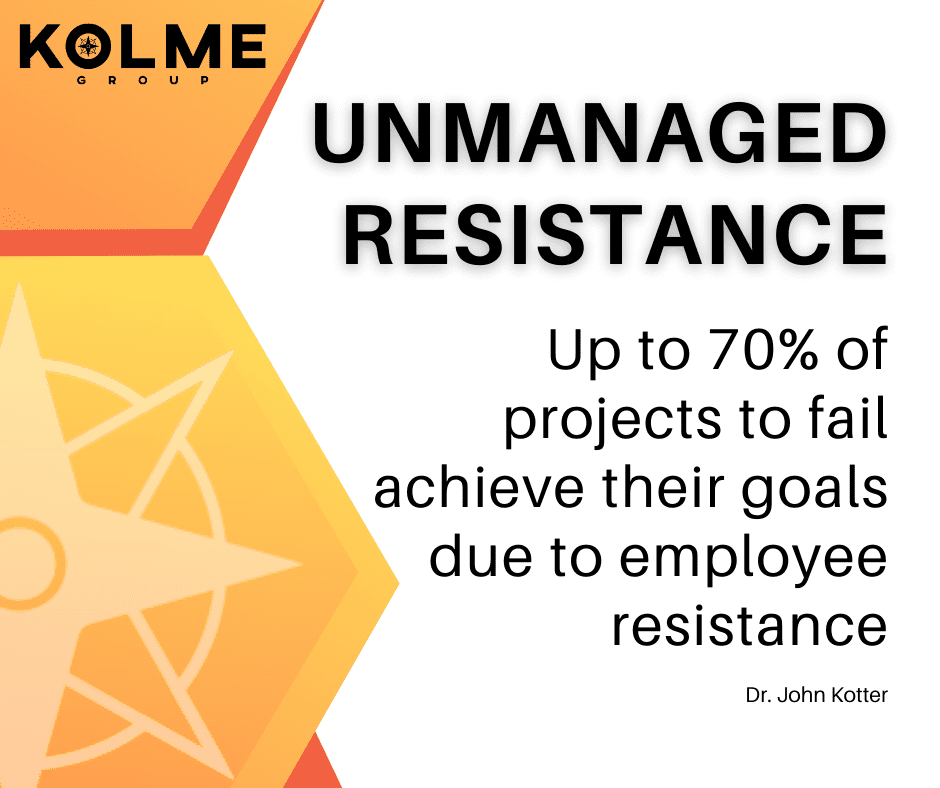
How to Manage Employee Resistance to Change
Resistance to change is normal but can block change success if left unmanaged. 70% of change projects fail to achieve their goals largely due to employee resistance. With Change Management, we can support the impacted people and groups through the change process and manage resistance to minimize the impacts.
Resistance in people can occur because change can sometimes create anxiety, fear, misunderstanding, etc.
One person’s resistance could present very differently from another, so it’s good to be aware of what resistance could look like. Here are some of the ways that resistance can present:
- Emotions such as fear, sadness, anger, anxiety, frustration, depression;
- Disengagement presented as ignoring, silence, apathy, indifference;
- Work Impact resulting in reduced productivity/efficiency, absenteeism, non-compliance;
- Acting out could present as conflict, arguments, aggressive or passive-aggressive behavior, and sometimes even sabotage;
- Negativity, such as starting rumors/gossip, miscommunication, complaints, focusing on problems
- Avoidance of the change, reverting to old behaviors, workarounds
- Building barriers such as excuses, counterapproaches, secrecy, and breakdown in trust
- Controlling is presented by asking lots of questions, defending the current state, attempting to influence outcomes
Ignoring resistance will ultimately result in a cost to the project and realization of the benefits. Resistance should, therefore, be anticipated, expected, and integrated into change management plans.
Managers should consider their direct reports and proactively identify challenge areas that they can foresee, as well as identify resistance within their team and how it might present for specific individuals.
These items, once identified, can then be planned for in communications, training, and coaching.
Reinforcement
Reinforcement’s purpose is to sustain change. Because people naturally tend to revert to what they know and are comfortable with, reinforcement should be part of the full change journey. It should be part of the initiative from the early stage, right to the end, and even afterward to sustain and ensure the adoption of the change. It may revert to the former state if you don’t reinforce the change.
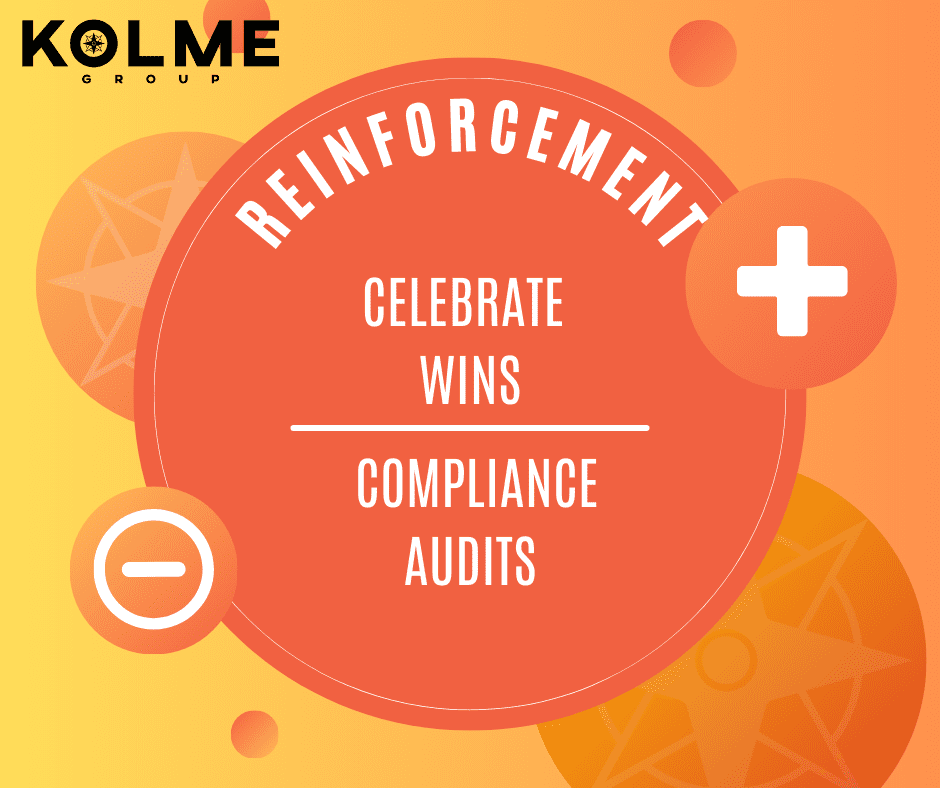
How to Reinforce Positive Reactions to Change Management
Reinforcement can take different forms. It can be positive and negative.
- Celebrate wins by giving praise, awards, and even gamification for healthy competition are good ways to reinforce progress. It helps to build momentum and maximize success.
Accountability checks.
- Regular compliance audits can identify gaps and serve as reminders of responsibility and accountability.
Dashboards & report cards.
- If automated generation of audit information can be created, this is a great way to reinforce positive actions and highlight gaps and non-compliance.
Building reinforcement requires constant application across the board.
Both resistance and reinforcement must be addressed promptly from the early stages of the project and consistently through to the end, even after the project has been completed and closed. Achieving the key benefits of the initiative depends on the long-term adoption of the change, and that will only happen if reinforcement strategies are in place.
Change Management Tools
ADKAR Model
Part of the 3 phases of the Prosci methodology is the ADKAR model. ADKAR is an acronym for the stages of change an individual will go through during their change journey.
- Awareness is the first stage. People must first be aware of the need to change before considering it. They should understand why the business is changing, what exactly is changing, and why now.
- Desire comes next. Once people are aware, they need to have the desire to change. They need to understand the vision and benefits of change to continue their change journey.
- Knowledge is knowing how to change. This involves communication and training, usually theory, but practical training is helpful too.
- Ability will follow and allow people to put the steps, skills, and behaviors they learned into practice. This requires support and permission to try and sometimes fail before being successful.
- Reinforcement is the stage that doesn’t end when the project closes. This is the step to support and reinforce the change with people. Good behaviors should be rewarded, and bad habits need to be addressed.
People will be assessed at different times in the project by responding to a 5-question ADKAR survey. The survey results will allow the Change Manager to measure people and their progression through the ADKAR phases and trend the results from survey to survey. The information will help identify if groups or individuals require different support or coaching to help them through the change journey.
PCT
Prosci Change Triangle (PCT) is another tool used to assess areas of strength and weakness related to Leadership/Sponsorship, Success, Project Management, and Change Management for the project in the organization. It allows the Change Manager to leverage the areas of strength and strengthen the areas of weakness.
Conclusión
The Change Management Process is a crucial framework that recognizes the inevitability of change and emphasizes the importance of managing its impact on individuals within an organization. As Jack Welch wisely noted, leading change before it becomes necessary is a key to success in the dynamic business landscape.
In essence, the Change Management Process is a holistic approach that recognizes change not as an abstract concept but as a transformational journey for individuals within an organization. By prioritizing the human element, organizations can navigate change with resilience and ensure it becomes a positive force for growth and progress.
Embarking on a successful Change Management journey requires expertise and strategic guidance. If your organization is gearing up for transformative initiatives and seeking comprehensive change management solutions, it’s time to connect with Kolme Group.
With a proven track record and a wealth of experience, Kolme Group specializes in tailoring Change Management strategies to meet your unique needs. From assessing organizational impact to implementing effective communication plans and sustaining change through reinforcement strategies, Kolme Group is your partner in navigating the complexities of change.
Don’t let the fear of the unknown hinder your progress – take the proactive step today. Reach out to Kolme Group for a personalized consultation and unlock the full potential of your organizational change. Your success story begins with a conversation – contact Kolme Group now to pave the way for a seamless and successful transformation.
